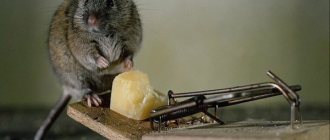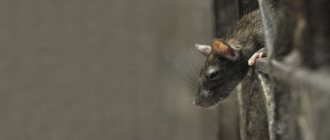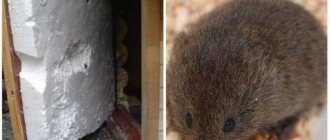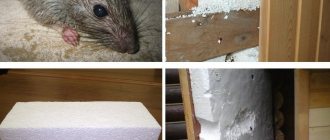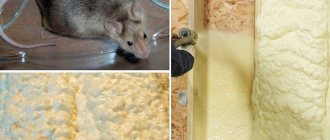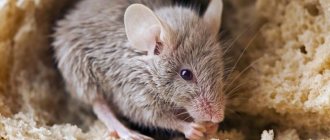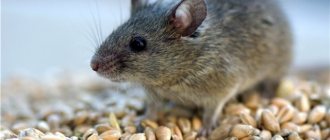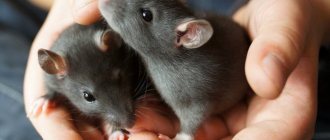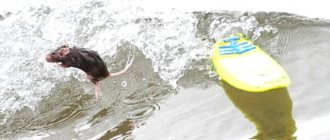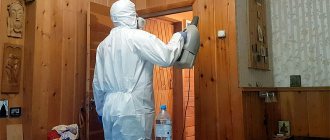If a mink is a noble rodent, then a mouse and a rat are unlikely to be so. Of course, there are decorative home varieties. But now it’s not about them. Rodents can ruin all your efforts to insulate your home. Therefore, you need to know whether mice breed in mineral wool, as well as in other thermal insulation materials.
When performing insulation, everyone tries to make the correct calculation, leave ventilation gaps, remove unwanted cracks, think about the likelihood of cold bridges, and also avoid shifting the dew point inside the walls.
But all these efforts become in vain when mice, as well as their larger counterparts, rats, begin to chew through the insulating material.
It’s hardly worth talking about whether mice live in sawdust. This is a natural material, and even food for them. So yes.
But what about other materials? What mice don’t gnaw, where they definitely don’t breed, and in what cases the likelihood of meeting such neighbors is highest. Let's figure it out. While you're reading, you can also grab something to chew on. Unless, of course, photos of rodents displace you.
Popular insulation materials and their disadvantages
Nowadays, the most popular thermal insulation materials for walls, floors and ceilings are polystyrene foam and mineral wool in various variations. They are valued for their light weight, ease and speed of installation. Indeed, their installation takes much less time than plastering wooden walls with clay mixed with straw or sawdust. And it can be done without any special physical effort. And the efficiency of such thermal insulation is significantly higher as a result.
However, these popular materials, among other disadvantages, have one serious disadvantage: they are liked not only by home owners, but also by rodents, as they are an excellent warm and safe refuge for them. This does not mean that you need to abandon them and look for which insulation does not harbor mice and insects. Moreover, it is difficult to find an alternative to mineral wool and PPP in terms of price/convenience/efficiency ratio. You just need to think about reliable protection of the thermal insulation layer from unwanted attacks.
It’s easier to keep rodents out of your home than to evict them Source hemingpestcontrol.com
We'll tell you how to do this later. There are many such methods and they all work quite well. But to be able to make an informed choice, it is necessary to have complete information about all insulation methods if someone still wants to use insulation that is not chewed by mice.
Modern technological processes
The starting material is melted in a cupola furnace at a fairly high temperature of 1000-1500 degrees. After the fiery-liquid mixture is obtained, the moment of drawing out the fibers comes.
The current process uses the following technologies:
- blowing;
- centrifugal roller;
- centrifugal-blown;
- other modified methods and techniques.
Examining the structure in detail, we come to the conclusion that these are chaotic fibers, the lengths of which are completely different, the thickness fluctuates within normal limits, drawn from glass waste.
In terms of heat capacity, they differ slightly from each other. Due to the fact that the fibers are able to create an air cavity, which in turn fixes the air in a stationary state, the material is so popular. Although before purchasing, the buyer is interested in the question of whether mice chew it or not?
Rodent resistant materials
Rats and mice, trying to get into a house where it is warm and nourishing, can even gnaw through wood, not to mention less dense materials. They do not eat the insulation, but remove the obstacle that prevents them from reaching the target. Or they make warm nests in it, protected not only from the cold, but also from natural enemies who are unable to reach them through enclosing structures and narrow cracks.
Therefore, there is no need to doubt whether mice live in mineral wool. They live well, breed and reach living quarters in search of food. Because this material, like polystyrene foam or polyurethane foam, is easy for their teeth and does not cause any harm.
Nest with brood in insulation Source city-michurinsk.rf
To prevent rodents from damaging the insulation, the material must be either very hard, poisonous to them, or unsuitable for habitation. And such insulation systems exist.
Foam glass
Since foam glass (or foam glass) is not the most common and little-known thermal insulation material to the average consumer, it is worth talking about it in more detail.
The low popularity of the material is explained by its high cost. It is produced from broken glass and glass production waste by melting and foaming the molten mass. Air bubbles enclosed in the cells of the material retain heat well. This is insulation that is not chewed by mice and is not afraid of moisture, as it has a very solid structure and mineral origin. Available in the form of slabs, blocks or loose granules.
The color of the material is gray, granules and crumbs are similar to expanded clay Source hemix.com
- Foam glass blocks and slabs are used to insulate facades; they can be plastered or tiled.
- Loose form of foam glass is used for thermal insulation of floors and ceilings
In addition to the listed advantages, foam glass has other advantages. Unlike cotton insulation, it does not shrink or change shape. It does not harbor insects and harmful microflora. And in terms of durability it surpasses all known thermal insulation materials.
Bulk insulation
Bulk insulation materials that are not damaged by rodents include expanded clay, vermiculite, and perlite.
Vermiculite and perlite are insulation materials in which rodents do not live. It is made from molten and foamed rocks of volcanic origin. Simply put, this is sand processed in a certain way. Therefore, it has much in common with granular foam glass and has similar properties and characteristics. Vermiculite differs from perlite only in that additional mineral additives are introduced into its composition.
White – perlite, colored – vermiculite Source gardensavvy.com
See also: Catalog of companies that specialize in home insulation
Expanded clay is a lightweight porous material made from clay fired at high temperatures. Depending on the size and shape of the particles, they are divided into:
- expanded clay gravel in the form of smooth round pellets with a diameter of up to 40 mm;
- expanded clay crushed stone in the form of crushed pellets of irregular shape with sharp edges;
- expanded clay sand – screening of crushed stone and gravel or crushed fine material.
To understand whether mice breed in expanded clay or other similar insulation, it is enough to imagine rodents trying to chew hard granules. Even if they succeed, the passage will immediately be blocked by another particle of moving material. It won't be possible to make a hole in it either.
In addition, a thick layer of bulk insulation does not allow air to pass through well; there is simply nothing to breathe in it. Vermiculite generally has the ability to absorb odors, and mice and rats try not to detect themselves by the trail of their own aromas, so they will not linger in it.
By insulating the floor with expanded clay, you don’t have to worry about mice settling under it. Source pol-exp.com
Despite the fact that expanded clay and mice are incompatible concepts, such insulation is not the most popular. They can only insulate horizontal structures or be used as backfill in double masonry. And for effective thermal insulation you need a fairly thick layer of material, so it is mainly used to insulate ceilings in attics and the floor of the first floor.
Ecowool
Ecowool by its name alone indicates the natural origin of the raw material. Indeed, it is shredded paper waste, and mice not only gnaw paper, but also eat it with pleasure. However, in production, this insulation is impregnated with brown acid, orthophosphoric acid and other substances that are safe for humans, but harmful to rodents and insects. When they enter the body, they cause severe thirst, and in the absence of water in close access, the mice cannot stand it and give up trying to settle in this soft and warm material. Therefore, we can say that ecowool is an insulation material that mice and rats are afraid of, despite its natural composition.
Protection against mice and rats entering the house.
What are mice and rats capable of?
Rats and mice can:
- Climb into the house using plants, trees, vines, plants, electrical wires, ropes. Climb to any height along vertical walls made of wood, brick, concrete, plastic. Crawl through pipelines, cable ducts, ventilation pipes, underground communications inputs (through gaps ). Rats are capable of: crawling into cracks of at least 1.3 cm, climbing outside vertical pipes with a diameter of up to 7.6 cm, climbing inside pipes or gaps ranging from 3.8 to 10.2 cm, burrowing to a depth of 90 cm, swimming in water at a distance of up to 800 m, jump up or in length by 33 cm. Mice are capable of: crawling through holes with a diameter of up to 6 mm, jumping to a height of 46 cm, surviving and reproducing at temperatures down to – 4C.
Standard entry points for mice and rats into the house.
Inputs of water, gas, electricity lines into the house, ventilation openings not protected by mesh, cracks in walls, vents in foundations, gaps at the joints of structures, ventilation gaps in roofing systems, sewer pipes, chimneys and chimney penetrations through walls and roofs, open entrances doors and windows, ventilation gaps of ventilated facades,
The best method of protecting your home from rodents is to create physical barriers to prevent rodents from entering your home and its structures. The additional cost of designing and installing mouse protection will be less expensive than repairing the damage caused by mice.
Ill. No. 3. Methods of mechanical protection of the house from the penetration of mice and rats.
To protect openings and ventilation gaps (in the roof, under ventilated facades) from mice, it is necessary to use a steel mesh with a cell size of less than 6 mm.
Steel of at least 0.56 mm thickness can be used to create rat- and mouse-proof barriers. The minimum thickness of a brickwork or unreinforced concrete wall to resist mice and rats is 9.5 cm. The minimum thickness of steel mesh reinforced concrete is 5 cm.
To protect against undermining and the penetration of rats, the foundation must be buried more than 90 cm into the ground, or equipped with an underground curtain at least a meter deep made of galvanized steel mesh with a mesh size of no more than 6 mm. A monolithic reinforced concrete foundation in the form of a slab is the best way to protect a house from the penetration of rodents through the ground, as well as reinforced concrete floors of the first floor. To protect against gnawing, the bottom edge of wooden doors can be protected by wrapping it with sheet metal at least 0.56 mm thick.
To protect against rodents climbing the walls, continuous circular ebbs can be used around the perimeter of the foundation, protruding at least 36 cm from the foundation, or a continuous decorative strip of smooth metal along the perimeter of the house with a height of at least 35-45 cm.
Bibliography:
SE Hygnstrom Impacts of house mouse activity of five types of insulation. Proceedings of the Fifteenth Vertebrate Pest Conference 1992/University of Nebraska.
– Lincoln, 1992.SE Hygnstrom House Mouse Damage to Insulation. Nebraska Swine Reports/University of Nebraska. – Lincoln, 1996. M. Suss, B.
Mittrach. 1982. Mause zerstoren fast jeden Dammstoff/ Landtechnik 37, – 1982.
P.81-83.RO Baker, GRBodman, RM Timm Rodent-proof construction and exclusion methods. Prevention and control of wildlife damage / University of Nebraska. – Lincoln, 1994.
Video description
An example of how mice “taste” the insulation, but do not stay in it, in this video:
However, rodents can gnaw passages in ecowool to get to more “edible” material. How can they build nests in insulation that was produced in violation of technology and is not impregnated with special compounds.
Ecowool is considered one of the best thermal insulation materials, as it is installed without seams, is not afraid of moisture and has good fire resistance due to fire retardant impregnation. Its disadvantages are the difficulty of installation by spraying and large shrinkage when installed in bulk.
Ecowool
Having considered the characteristics of thermal insulation materials that attract rodents, you can understand which materials should not be used during repair and construction work.
One of the possible options is ecowool. Rodents do not live in it, although the material belongs to the cotton wool group. The basis of this material is formed by cellulose. The material does not burn and does not emit toxins. This is not only durable insulation with high thermal insulation properties, but also excellent sound insulation. Condensation does not accumulate in ecowool.
The material is applied to the surface using pneumatic tools or manually. Therefore, the cost of such finishing is quite high. The material should dry at normal humidity for 3-4 days.
Ecowool repels mice and rats due to its special composition, which includes brown salts and high concentration boric acid. These substances are safe for human health, but they are dangerous substances for rodents. Also, fungus will not appear in ecowool and pathogenic microorganisms will not develop.
How to protect insulation from rodents
Having chosen mineral wool or polystyrene foam boards as insulation, you need to think in advance, even before installing it, about measures to protect it from rodents. Some developers use glass wool, believing that small particles of glass will repel mice. In fact, mice also live in glass wool, because they do not eat it. You don’t even have to gnaw on the loose material – it easily bends under the weight of the animals, and they can squeeze through the slightest crack. Therefore, you just need to keep them out of the insulation or scare them away.
Metal mesh barrier
Fine-mesh steel mesh is a reliable barrier for mice. It can be attached to joists and floor beams when insulating the floor, to frame posts when thermally insulating walls under a curtain wall. If the walls are plastered, the mesh will serve not only as protection against pests, but also as a reinforcing frame. But in this case it is better to choose galvanized products.
What is basalt wool?
Basalt wool is a high-density insulation material; it has replaced the impractical and traumatic glass wool. At the moment, sales of this particular insulation are in first place, accounting for 80% of the total sales of mineral wool. Basalt mineral wool contains the finest elastic fibers, which are obtained by melting and rapid cooling. As a result, stone fibers are formed.
Important! In the production of stone mineral (basalt) wool, rocks are used. This is what makes it possible to achieve high quality and long service life.
Important Features:
- Mineral wool is used to insulate any buildings and structures.
- Can be used on ceiling, floor, walls, roof.
- The material is environmentally friendly, so it can be successfully used in premises of any purpose.
- For seamless insulation, blown-type basalt insulation is used, which has high technical performance.
Briefly about the main thing
Without high-quality thermal insulation, it is difficult to create normal living conditions in a house so as not to freeze in winter, spending a lot of money on heating, and not swelter from the heat in summer. But the effectiveness of the insulation may come to naught if there are mice in it. They are not at all attracted to foam glass, expanded clay, penoizol and cellular concrete insulation, but these materials have too many disadvantages compared to such modern insulators as mineral wool and expanded polystyrene. Therefore, you need to know what ways you can protect them from rodents or scare them away.
Ratings 0
Ultrasonic generators
What to do if the house has already been built, and despite all the preventive actions, it is still attacked by rodents? There are many proven ways to eliminate mice, among which a very effective and environmentally friendly method is the use of ultrasonic repellers. These are devices whose operating principle lies in the emission of sound waves that are not audible to the human ear. At the same time, rodents clearly hear an unpleasant sound, which forces them to leave the area of influence of the device. Such devices are effective not only against mice - installing an ultrasonic repeller can also rid an area of larger rodents - rats, moles and other pests.
Having a cat in the house, or better yet several, can help prevent the appearance of small pests. Everyone knows with what pleasure hunter cats exterminate rodents. Indeed, even the smell of a predator repels rodents. But this doesn't always work. You may come across a cat that will live in the same territory with mice in complete harmony, without causing them any harm. Natural enemies of small rodents are weasels and stoats. Several of these domesticated animals can quickly clear a house of mice.
